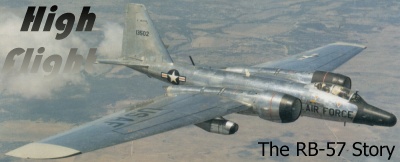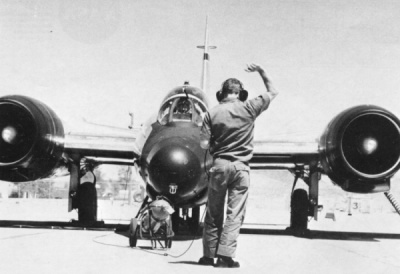

The B-57 started its life as the English Electric Canberra bomber. During a flyoff in 1951, the British Canberra won out over other aircraft such as the B-45 Tornado, the AJ-1 Savage, and the XB-51. Early on in the testing phase, Martin changed the cockpit layout from the British style to a more typical tandem seating arrangement. This was the most distinguishing difference between the British and American Canberra bombers. The great high-altitude performance and large payload capacity of the B-57 made it an obvious choice for an interim high-altitude reconnaissance platform. While the specialized U-2 was being developed, Martin modified B-57Bs to the RB-57D standard, fitting more powerful engines and increasing the wing length from 64 feet to 106 feet. A limited flight test program showed that the new wing required strengthening of the spars and wing panels. Once these changes were done, the RB-57Ds went to Japan and Alaska for ELINT/SIGNET work over China and the Soviet Union.
The missions of the RB-57D were simple, but the gathering methods were widely varied. The large capacity of the RB-57D made it ideal for a wide range of gathering equipment. One RB-57D was equipped with a high-resolution side-looking radar that could be used day or night for mapping reconnaissance. Flights over China and the Soviet Union were focused primarily on nuclear test sites, although other areas of interest were targeted. The US also trained Taiwanese crews on the RB-57D and provided them with the planes to carry out intelligence gathering of their own. While this was going on in the Pacific, a four plane detachment made its way to Germany where they were put to use over the Iron Curtain. These missions gave a hint at a large future of the big-winged Canberras, as in addition to the standard ELINT/SIGNET gathering these RB-57s also did air sampling missions.
The life of the RB-57D was short-lived, however, as the problems with the wing spar shortened its career. Before it went out of service, though, it found its way into the hangers of NASA, who used them for high altitude research and mapping. The Air Weather Service also got a few for weather research. Radar calibration and nuclear testing were two other areas that the RB-57D saw service. Through extensive work by Martin consisting of rebuilding the failing wings, the RB-57D managed to stay in service a bit longer, with the last one being retired from service in 1970.
The need for a high-altitude reconnaissance platform with a large payload capacity was still on the Air Force’s mind, especially when the RB-57D was experiencing its wing spar problems. The Air Force approached General Dynamics with the problem and asked about modernizing the RB-57. General Dynamics worked hard on the project and in the end came up with an almost new plane. In looking at the RB-57F, very little remains of the original British jet. The tandem canopy is almost the only link to the original B-57B that it was based off of. The wing was increased in size all around, with the final wingspan being 122 feet with an area of 2000 square feet. This huge wing presented one problem in that once in the air, the RB-57F didn't want to land. The ground effect kept this plane up, requiring a long runway. The engines were also replaced with more powerful TF33 turbofan engines that gave the RB-57F 50% more power over the RB-57D. Supplementing that power was two turbojet engines mounted in pods under the wing. These added another 6000 pounds of thrust, giving the RB-57F a total of 38,000 pounds of thrust. This power enabled the RB-57F to carry a heavy payload to altitude quickly. Other changes included a much larger fin and rudder and a new nose. When the first RB-57F took to the air on June 23rd, 1963, it showed no serious problems and actually handled better than its predecessor, the RB-57D.
With the flight characteristics of the RB-57F under control, the Air Force put an order in for 19 airframes, not including the first one. These quickly went to work, using new side-looking cameras that could take detailed pictures from nearly 60 miles away. Since the Powers U-2 incident, flying over enemy territory had been curtailed. The performance of the RB-57F really shined under these circumstances, as its high altitude performance allowed it to take pictures of Soviet activity from NATO borders. Even though the RB-57F stayed inside NATO borders, it was fired upon, and in one case, an RB-57F was shot down, with the loss of both crewmen. This was the only operational loss, although two were damaged while serving in Pakistan.
As satellites and the SR-71 came into service, the RB-57F was relegated to the weather service, and they were redesignated WB-57Fs. They continued to fly high, this time gathering radioactive dust and other airborne matter. The Air Force opened up this wonderful research tool, and many agencies took advantage of it. NOAA, USDA, FAA, and others all utilized the WB-57F for a wide variety of tests and experiments. For a list of some of those experiments, take a look at the list on the right. In addition to military studies, many projects with global impact were undertaken. The first color photo of the eye of a hurricane was taken from a WB-57F. Pollution, air turbulence, and thunderstorms all came to the attention of the WB-57F aircraft.
In addition to the Air Force, NASA expressed an interest in the WB-57F. The Air Force and NASA entered into a contract that allowed NASA to use one of the WB-57Fs. This plane was used for space research, in addition to mapping and air sampling. When the Air Force phased the WB-57Fs out of service, NASA picked up 2 more airframes and continued to use them for high-altitude research. This work continued on until 1985, at which point all of the WB-57Fs were mothballed at Davis Monathan AFB.
The RB-57F was the end of a long line of US-modified B-57s. Its long, graceful wing took it to altitudes far above those of conventional planes. The amount of information it brought back was immense. The gathering done by NASA and the Weather Service alone is incredible, proving many theories and showing the need for a high altitude research aircraft. The replacements that NASA and the Weather Service got were inferior to the WB-57F in that they could not get to the same altitudes as the WB-57F could. With information needed in high altitude atmospheric research, it may be that the WB-57Fs might make a comeback, if any are still in mothballs at DM. To have the skies graced by the presence of this long-winged Canberra would truly be a joy to see.

Projects of the 58th WRS:
AFETR SUPPORT
Weather reconnaissance for Eastern Test Range
APOLLO
Launch/recovery area weather reconnaissance for NASA
AURORA
Gathered penetrating radiation data produced by the aurora phenomenon
BATELE NORTHWEST
Monthly particulate sampling in the vicinity of Richland, WA for the Atomic Energy Commission
BOMEX
Barbados Oceanographic and Meteorological Experiment; to analyze the ocean and atmosphere and the interaction between the two
CAT
Clear air turbulence studies conducted for the Air Force Cambridge Research Laboratory, NCAR, and NOAA
COLD BOUNCE
An Air Force Avionics Laboratory laser project to determine atmospheric effects on reconnaissance photography
COLD BURN
Sampling of fragmentation and ablations from meteoroids on an "as required" basis for the Smithsonian Astrophysical Observatory (SAO)
COLD CAN
A joint USAF/Canadian project to determine the vertical and latitudinal distribution and measurement of gaseous elements above tropopause levels through the use of a solar spectrometer
COLD CAR
High-altitude measurements emphasizing chemical and meteorological analyzes for the National Center for Atmospheric Research
COLD CHUCK
Special Southern Hemisphere Reconnaissance Operations
COLD CONE
WB-57F arrived over Vandenberg AFB 30 minutes prior to a missile launch window, then sampled exhaust trail
COLD COURSE
A high-altitude performance assurance project flown for the FAA to test the capability of radio aids while flying at extremely high altitudes
COLD CUT
Mission t collect particulate and whole-air samples for the Air Force
COLD DOME
Domestic reconnaissance operations possibly concerning the USDA/NASA operation to track down a devastating corn disease.
COLD FLARE
This was a NASA/FAA project to study high-altitude solar flare activity in preparations for the establishment of intercontinental polar routing of supersonic transport flights
COLD FLOOR
Measuring of atmospheric absorption and scattering indices
COLD FLOW
An effort to determine the motions of the atmosphere and migration of pollutants
COLD HUNT
Support of NASA/MSFC Airborne Visual Laser Optical Communication Project
COLD RAP
Conducted in conjunction with NASA for earth resources studies
COLD RAY
Cosmic Ray research for the Atomic Energy Commission
COLD REX
A highly classified project utilizing a specially equipped RB-57F. Required rapid reaction deployment and world wide commitment. Possibly nuclear cloud sampling program
COLD ROUTE
A USAF project requiring the collection of particulate and whole are samples
COLD SAND
Atmospheric Sciences Laboratory White Sands Missile Range/Meteorological satellite comparison data over WSMR
COLD SCAN
A piggy back mission flown for the Canadian National Aeronautics Establishment. Measured turbulence in connection with Supersonic Transport study
COLD SPECK
Classified special accelerated operations conducted for the USAF
COLD SPLASH
Conducted at Kwajalein Missile Range for SAMSO Minuteman tests, Weather Data Acquisition Plan.
COLD TEMP
Air sampling for the USAF
COLD TOP
Air sampling for the USAF
COLD TOY
Support to AFCRL for weather radar techniques, weather modifications, research and cloud physics, predictions of upper air circulations, and atmosphere sensing technique utilizing Loran C/Omega windsonde system
COLD WAVE
Airborne spectrometer experiment for Air Force Avionics Laboratory
COLLEGE HUNTING
Provided high-altitude targets for Aerospace Defense Command and interceptor training.
CROSS CHECK
See PADDLEWHEEL
METROMEX
Metropolitan Meteorological experiment to determine effects of a large city on the weather
MOUNTAIN WAVE
A joint US/British operation flown over the mountainous areas of the Western US. Turbulence measuring equipment studied the effects of mountain wave activity on upper air turbulence
NCAR
Tropopause Folding Experiment and Atmospheric Research. Included sulfate sampling, Colorado Lee Wave Experiment, and sampling of volcanic emissions
NOAA/EML
NOAA/Experimental Meteorology Laboratory comprehensive investigation of the characteristics of tropical shower clouds
PADDLEWHEEL
Tested the readiness of all participating agencies to conduct atmospheric nuclear testing coordinated and commanded by Joint Task Force Eight
ROCKET PLUME
Flown form AFSC to take samples of rocket exhaust. Determined the concentration of hydrochloric acid in the exhaust of Minuteman and Titan IIIC engines
ROUGH RIDER
Conducted by the National Severe Storms Laboratory. Obtained high-altitude photographs of thunderstorms and gust measurements in the clear air in the vicinity of thunderstorms
SECEDE III
NASA experiment, in which a rocket was fired from Alaska into near space where it released a barium cloud
SLURRY
Air Force Special Weapons Center developed a non-nuclear cloud for the 58th WRS to practice hot sampling techniques
SPINNAKER BRAVO
Simulated nuclear test drop off the southern California coast, utilizing the sampling array technique and follow-up sampling by nine RB-57F aircraft.
STORM FURY
Department of Commerce(NOAA)/Department of Defense project providing accurate photo recon of AWS tropical cyclone seeking operations, designed to change the force in the clouds around the eye of the hurricane
B-57 Canberra in Action, Jim Mesko, Squadron/Signal Publications Inc., 1986.
Air Monograph 91, RB-57 Long Span Type, Air World, Vol. 9 No. 4, Air World, Inc., 1985.
Martin/General Dynamics RB-57F, Aerophile, Vol. 2 No. 3, Aerophile, Inc., 1980.
